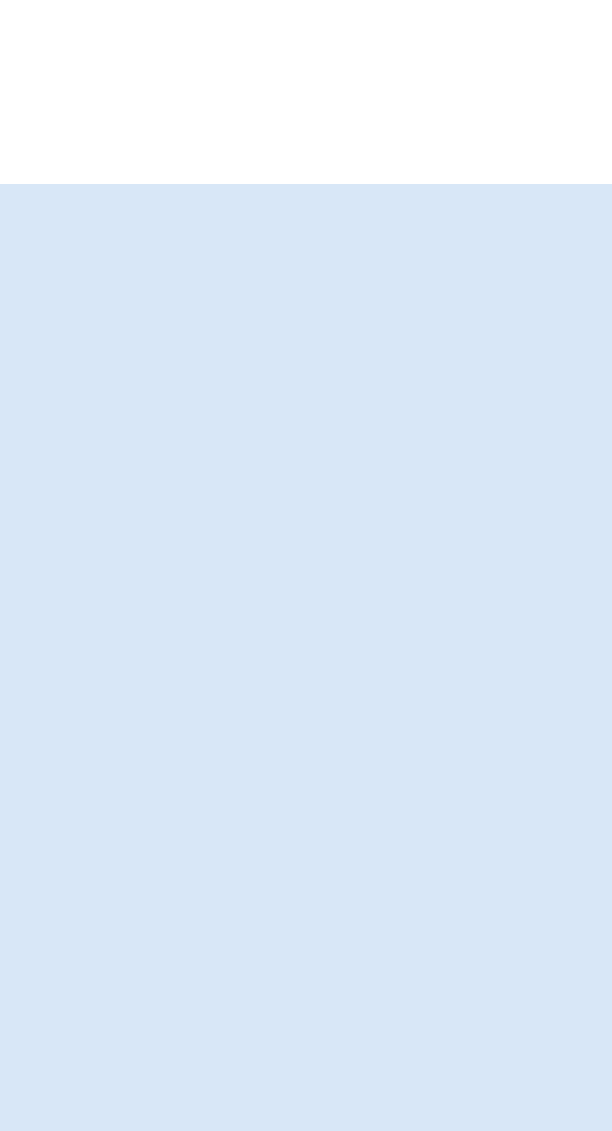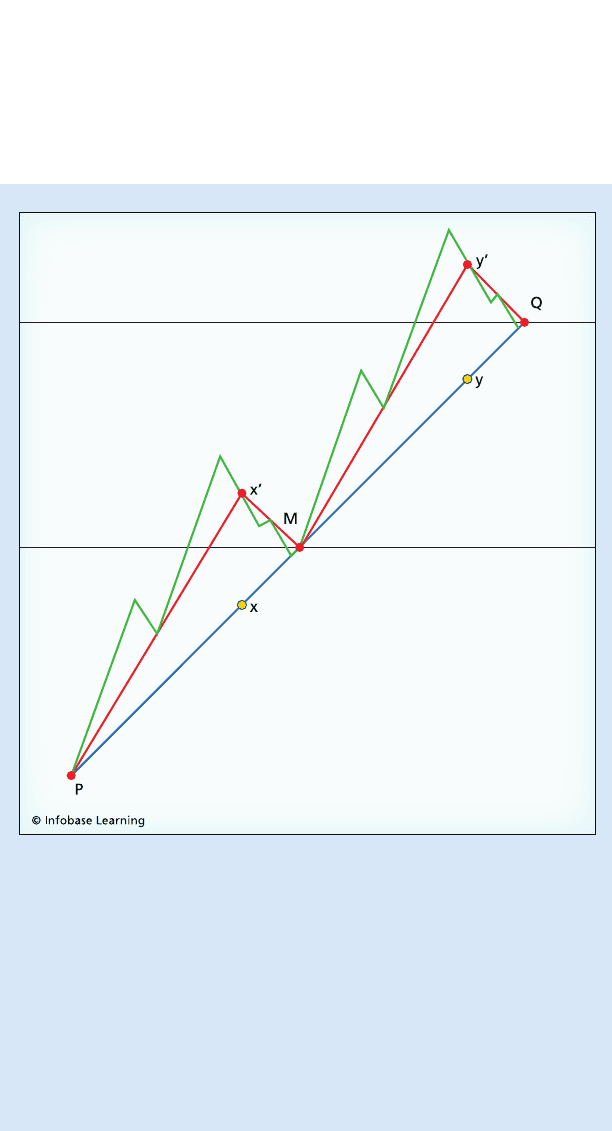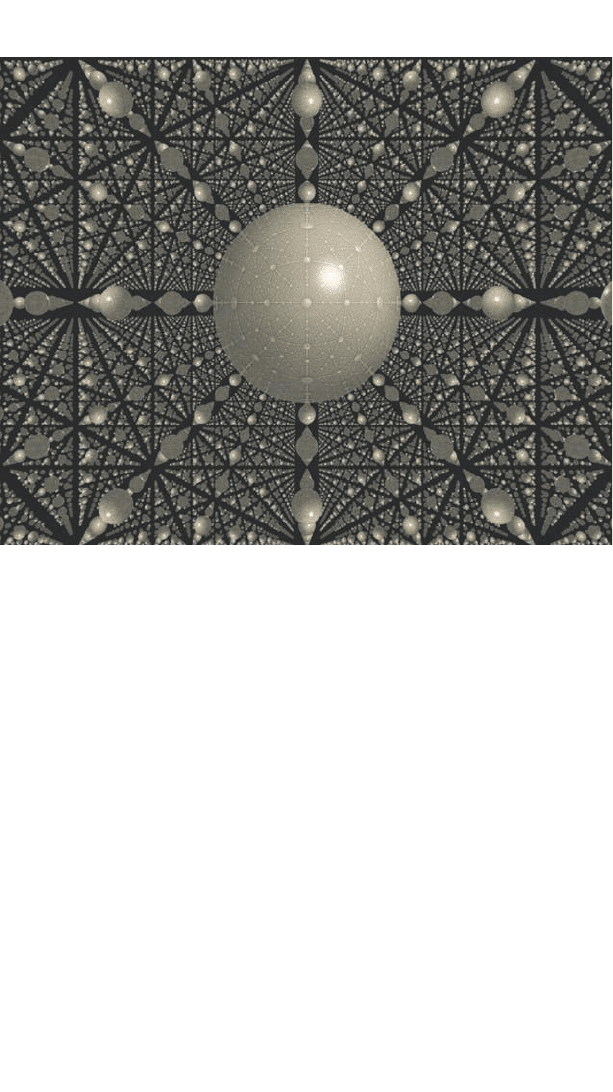Tabak J. Beyond Geometry: A New Mathematics of Space and Form
Подождите немного. Документ загружается.


30 BEYOND GEOMETRY
bit wordy because good algebraic notation had not been invented
yet, but in modern notation he noticed that he could define a func-
tion on the natural numbers according to the following formula:
counterexample 2: a continuous
nowhere differentiable function
The 18th-century belief that the points at which a function fails to have a
derivative are isolated from one another—and in that sense, “exceptional”—
is false. The first counterexample was produced by Bolzano. Here is his
method for producing a curve that is continuous at each point but fails to
have a derivative at any of its points. His counterexample dates to 1830.
Step 1: Draw a nonhorizontal line segment PQ and label the
midpoint of the segment M.
Step 2: Draw a horizontal line though M, and draw a second
horizontal line through Q. Find the point on the segment PM
that is three-fourths the distance from P to M, and label it x.
Find the point on the segment MQ that is three-fourths the
distance from M to Q, and label it y.
Step 3: Reflect the point x about the horizontal line passing
through M. Label this new point x′. Reflect the point y about the
horizontal line passing through Q, and label this new point y′.
Step 4: Using straight line segments, connect P to x′ and con-
nect x′ to M. Similarly, use straight line segments to connect M
to y′ and y′ to Q. The result is a graph with four straight seg-
ments and three corners.
Now repeat steps 1 through 4 on each of the resulting segments.
Continue to repeat steps 1 through 4 on each of the resulting seg-
ments to produce a graph with an ever-increasing number of corners.
This produces a sequence of graphs of functions. The formulas for the
functions in this sequence are not especially difficult to find, but the formu-
las are long and not especially informative. Instead of deriving the formulas,
label the first function f
1
. This is the straight line segment with which we
began. Label the second function f
2
. This function has the red graph. It rep-
resents the result at the end of step 4. If we repeat the procedure on each
segment of the red graph, we get the green one. Call the function with this
graph f
3
. By continuing in this way, we obtain a sequence of such functions
f
1
, f
2
, f
3
, . . . The further one goes in the sequence, the more closely spaced
the corners are placed on each graph. Now imagine vertical parallel lines.

A Failure of Intuition 31
f(n) = n
2
. His function paired each natural number n with a perfect
square n
2
: The number 1 is paired with 1; the number 2 is paired
with 4; the number 3 is paired with 9; and, in general, the number
No matter how close the lines are placed to one another, all functions with
a large enough subscript will have at least one corner somewhere between
those vertical lines. The sequence of functions described in the algorithm
determines a “limit function” that has corners everywhere. (The proof of this
last statement is too difficult to produce here.)
Bolzano’s procedure begins with the straight (blue) line. The red line is
obtained at the completion of step 4 of the procedure. The green line is
obtained after applying steps 1–4 to each of the straight segments that
make up the red line. Repeat again and again. The resulting graph
converges to one that is continuous and nowhere differentiable.

32 BEYOND GEOMETRY
n is paired with n
2
. As Galileo pointed out, it might seem that
there are far fewer perfect squares than natural numbers because
the percentage of perfect squares in the set consisting of the first n
natural numbers approaches zero as n becomes large, but because
the set of natural numbers is infinite, a one-to-one correspondence
can still be established.
Although he was careful to document his “paradoxical” results,
Bolzano never used them to develop a clear understanding of the
real number system. A clear conception of the real number system
did not develop until the latter part of the 19th century, when
mathematicians learned how to manipulate infinite sets. A deeper
understanding of infinite sets enabled them to obtain a new and
deeper understanding of mathematics in general. The mathema-
tician most responsible for establishing the theory of sets is also
generally credited with founding the modern era in mathematics.
His work also marks the introduction of general topology, which
he helped to create in order to overcome some of the problems
described so far in this narrative.

33
3
a new mathematical
landscape
During the latter half of the 19th century, modern mathematics
began to take shape. The geometric constructions of Leibniz and
Newton—a visual language that had proven to be inadequate to
describe subsequent discoveries—were finally replaced by a more
abstract language founded on the theory of sets.
At first glance, sets are about as primitive a concept as can be
imagined. The concept of a set, which is, after all, a collection
of objects, might not appear to be a rich enough idea to support
modern mathematics, but just the opposite proved to be true. The
more that mathematicians studied sets, the more astonished they
were at what they discovered, and astonished is the right word. The
results that these mathematicians obtained were often contro-
versial because they violated many common sense notions about
equality and dimension. Some mathematicians were left by the
wayside complaining about mathematical “absurdities.” The more
adaptable ones changed their notions of what constituted “com-
mon sense notions.” Georg Cantor, who did more than anyone
else in establishing the theory of sets, is said to have exclaimed
about one particularly remarkable proof of his own making, “I see
it but I don’t believe it!”
As these mathematicians learned more, they began to impose
additional structure on their sets. They began to distinguish
among infinite sets of different sizes and different (topological)
properties. Their research revealed an entirely new mathematical
landscape full of exotic mathematical objects, but more than the
answers they obtained, their research raised new questions. Ideas

34 BEYOND GEOMETRY
as basic to science and mathematics as that of dimension were
called into question. One of the accomplishments of set-theoretic
topologists is that their discoveries helped to restore order to
mathematics by identifying (or creating, depending on one’s point
of view) underlying patterns, the existence of which no one had
previously suspected.
Richard Dedekind and the Continuum
The German mathematician Richard Dedekind (1831–1916)
made an essential step in arithmetizing analysis by making explicit
the relationship between real numbers and the real number line.
The ancient Greeks had assumed that a line is a continuum of
points. They also assumed that, in contrast to the line, numbers
did not form a continuum. These two ideas, the continuity of lines
Some of the logical implications of the concept of infinity strike many people
as strange, even today. Part of what it means to learn mathematics is
becoming accustomed to the strangeness of the infinite.
(Casey Uhrig)

A New Mathematical Landscape 35
and the discrete nature of numbers, were accepted by mathemati-
cians for the next 2,000 years. In his famous paper “Continuity and
Irrational Numbers,” Dedekind questioned both ideas. He wrote
that the belief that the line forms a continuum was an assump-
tion—one could not prove this statement—but if the line were
continuous, so was the set of all real numbers. His conception of
the real number line continues to influence mathematics on an
elementary and advanced level today.
Dedekind studied mathematics at Göttingen University under
Carl Friedrich Gauss, one of the leading mathematicians of the
19th century. For seven years, he taught at the university level,
first at Göttingen and later at Zurich Polytechnic. For the next 50
years, he taught in Braunschweig, Germany, at the Technical High
School, a remarkable choice for one of the most forward-thinking
mathematicians of his age.
Since the time of the Greeks, irrational numbers had remained
something of a puzzle. Recall that rational numbers are numbers
that can be represented as the quotient of two whole numbers.
The numbers ½ and ¾, for example, are rational numbers, but
the number √2 is not rational because there is no choice of whole
numbers, a and b, such that their quotient, a/b, when squared,
equals 2. The number √2 is, therefore, an example of an irrational
number. More generally, the set of irrational numbers is defined
to be the set of numbers that are not rational.
Nevertheless, to defined something by what it is not yields very
little information about what it is. The definition of irrational
numbers as not rational goes back to the Greeks, who considered
geometry and arithmetic to be very separate subjects, in part
because geometry (as they understood it) dealt with continuously
varying magnitudes—lines, surfaces, and volumes, for example—
and arithmetic was concerned with numbers, which they regarded
as discrete entities, but to do analysis rigorously, mathematicians
needed a continuum of numbers. In other words, they needed as
many numbers as there are points on a line. Dedekind established
a one-to-one correspondence between the points on a line and the set
of real numbers. He demonstrated that he could “pair up” points
and numbers in the following one-to-one way: Each number was

36 BEYOND GEOMETRY
paired with exactly one point on the line, and each point on the
line was paired with exactly one number. Through his correspon-
dence, Dedekind demonstrated that the set of all real numbers
forms a continuum provided one was willing to accept the con-
tinuity of the real line. (To be clear about the concept of one-to-
one correspondence, imagine an auditorium in which everyone
is seated. If every chair is taken, then there are as many people
as chairs in the auditorium. If some of the chairs are empty, then
there are more chairs than people. We may not know how many
people or chairs are in the auditorium, but the concept of one-to-
one correspondence still enables us to draw conclusions about the
relative sizes of the set of people in the auditorium and the set of
chairs in the auditorium.)
In Dedekind’s model of the real number system, the rational
numbers play a special role. These numbers can be placed into
one-to-one correspondence with a subset of points on the real
line. To see how, begin with a line. Identify one point on the line as
zero, and identify a second point (to the right of zero) as the num-
ber one. Now measure off distances on the line corresponding to
the natural numbers. They are located to the right of zero and are
multiples of the zero-one distance. Once the points correspond-
ing to the natural numbers have been located, use them to iden-
tify points corresponding to the rational numbers. (Any rational
number can be expressed in terms of sums, differences, products,
and quotients of natural numbers.) Positive rational numbers cor-
respond to distances to the right of zero; negative rational num-
bers correspond to distances to the left of zero. We will call the
points corresponding to these rational distances “rational points.”
However, this procedure leaves numerous “gaps” in the line. It
does not, for example, generate a point corresponding to √2 or a
point corresponding to the number π, because neither of these is
a rational number. The question Dedekind sought to answer is,
“What is the nature of these gaps?”
Dedekind expressed his answer in terms of cuts of the real line,
now famously called Dedekind cuts. Each cut identifies a unique
point, which is the location of the cut, and every point determines
a unique cut. His method shows that there exist as many numbers

A New Mathematical Landscape 37
as cuts. In particular, he shows that the set of all real numbers
forms a continuum. Mathematicians now call this property “com-
pleteness,” but Dedekind wrote that his construction demonstrat-
ed that the domain of real numbers “. . . had the same continuity as
the straight line.”
To establish Dedekind’s correspondence imagine making a cut
at a point P, where P is some arbitrarily chosen point on the line.
The point P divides the set of rational points into two disjoint sets.
(Imagine a string stretched horizontally from left to right. Cutting
the string partitions the fibers of the string into two disjoint sets.
Some fibers lie to the left of the cut and some to right. No fiber
lies in both parts.) In just the same way, Dedekind’s cut partitions
the set of rational numbers into two sets, which we will call A
1
and
A
2
. Let A
1
be the set of rational numbers to the left of the cut, and
let A
2
be the set of rational numbers to the right of the cut. Each
number in A
1
is, therefore, less than each number in A
2
. But what
about P, the point at which the cut was made? Three possibilities
exist: P may belong to A
1
; P may belong to A
2
; or P may not belong
to either A
1
or A
2
.
If P belongs to A
1
, it is the largest element in A
1
, and it is also a
rational number because every element in A
1
is a rational number.
Also, if P belongs to A
1
, then P does not belong to A
2
because the
sets share no points in common. Consequently, the set A
2
does
not have a smallest number. To see why this is so, imagine that
A
2
did have a smallest number. Call that number Q. Because we
have already assumed that P belongs to A
1
and that A
1
and A
2
have
no elements in common, Q must be bigger than P, but between
any two rational numbers on the real line there is always a third
rational number distinct from both. If the third number existed, it
would not belong to either A
1
or A
2
, since it would be larger than
P and smaller than Q. This contradicts the fact that every rational
number belongs either to A
1
or A
2
. We conclude, therefore, that if
P belongs to A
1
, A
2
does not have a smallest element.
Now assume that P belongs to A
2
. Reasoning similar to that of the
preceding paragraph shows that A
1
cannot have a largest element.
Finally, suppose that P does not belong to either A
1
or A
2
.
Because every rational number belongs to either A
1
or A
2
, P must

38 BEYOND GEOMETRY
be an irrational number, but P corresponds to the unique number
that partitions the set of all rational numbers into the sets A
1
and
A
2
. The way that P divides the rational numbers also reveals which
irrational number corresponds to P. It is the unique number less
than every rational number in A
2
and greater than every rational
number in A
1
. (Only one real number satisfies both criteria.) In this
way, Dedekind showed that to each number corresponds exactly
one point and to each point corresponds exactly one number. He
concluded that the set of real numbers has the same continuity as
the line. (Notice that Dedekind’s correspondence allows us to use
the terms real number and point on the real line interchangeably, and
we will do exactly that in the next section.)
Georg Cantor and Set Theory
The German mathematician Georg Cantor (1845–1918) did more
than anyone else to place set theory at the center of mathemati-
cal thought. He was a creative mathematician with an unusual
background. In university, he studied philosophy and physics in
addition to mathematics. A mystic as well as a mathematician, he
hoped his research into the nature of infinite sets would reveal
something about the mind of God. The discoveries that Cantor
made about infinite sets were so unexpected that mathematics
journals were sometimes reluctant to publish his papers. Editors
were worried that the papers contained errors, although they
could find none. His research was so controversial that despite the
fact that he changed the history of mathematics, he was refused
a position that he wanted at the University of Berlin because of
the sensational nature of his discoveries. It was characteristic of
Cantor that he titled his Ph.D. thesis “In mathematics the art of
asking questions is more valuable than solving problems.”
Much of Cantor’s work involved the problem of classifying
infinite sets, and one of his main methods was the use of one-to-
one correspondences. When he could prove that a one-to-one
correspondence existed between two sets, he would conclude
that the two sets were equal in size. When he could show that a
one-to-one correspondence did not exist, he would conclude that

A New Mathematical Landscape 39
they were of different sizes. Cantor began by defining an infinite
set as any set that can be put into a one-to-one correspondence
with a proper subset of itself. (Recall that neither Galileo nor
Bolzano attempted to be precise about the sizes of the sets that
This sculpture by Charles Perry is titled Continuum. Cantor showed that
the continuum of real numbers cannot be put into one-to-one correspondence
with the set of all rational numbers. In other words, infinite sets come in
different sizes.
(Smithsonian National Air and Space Museum)
